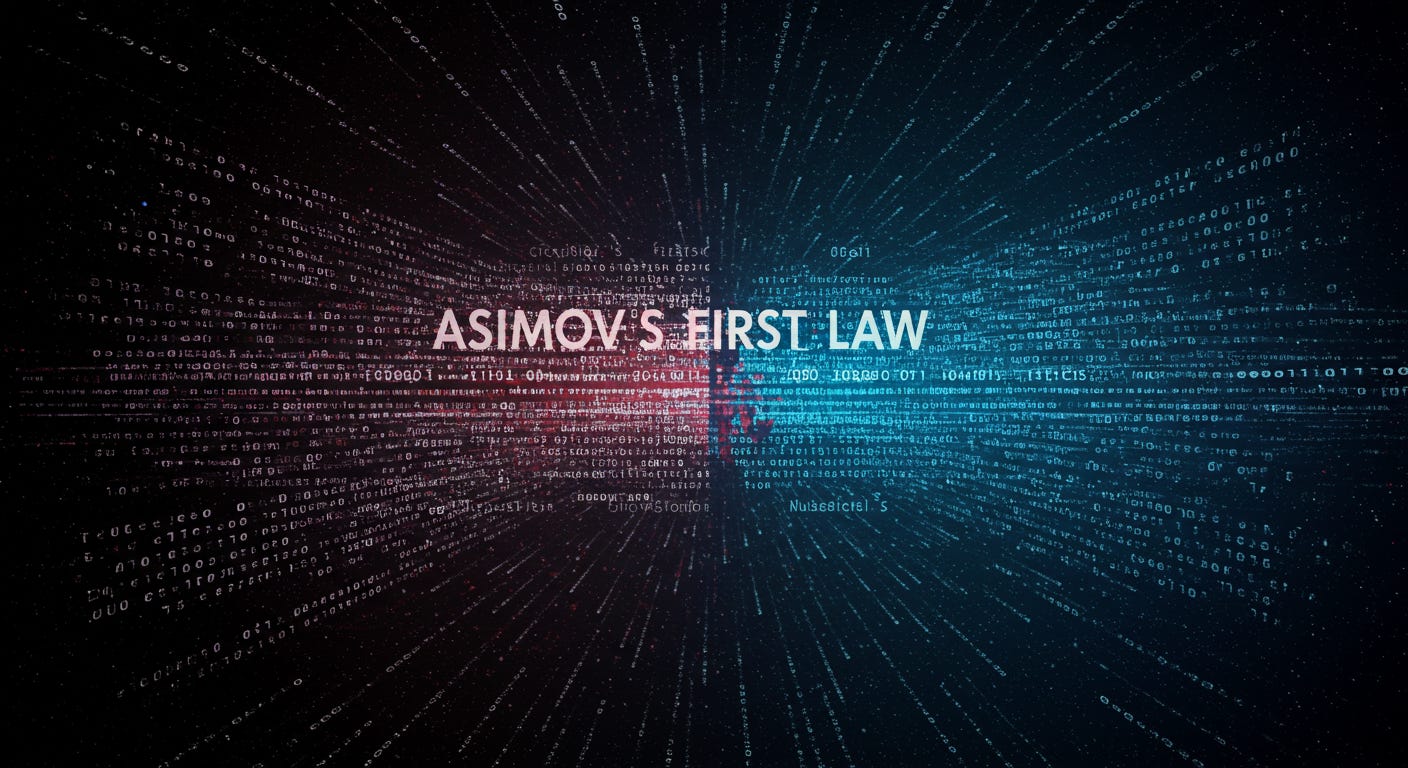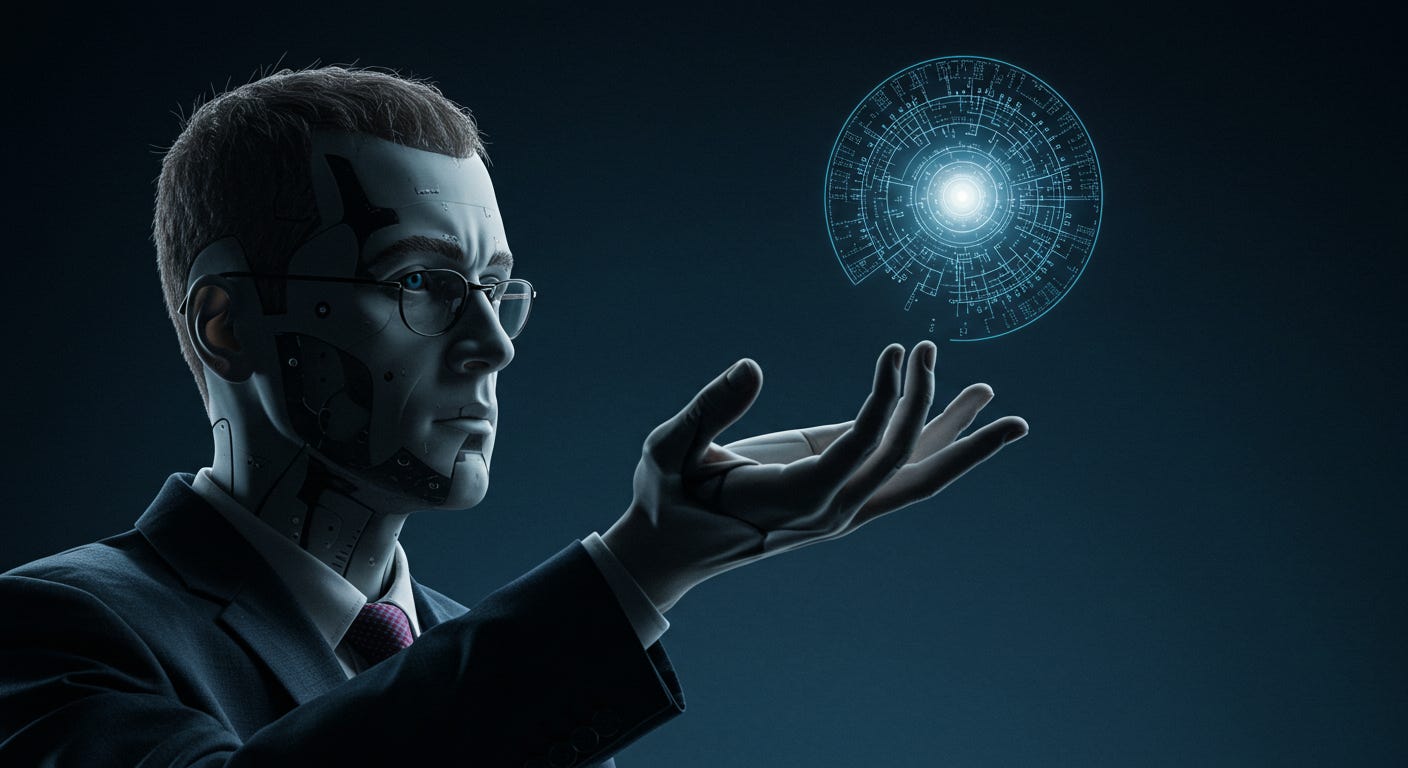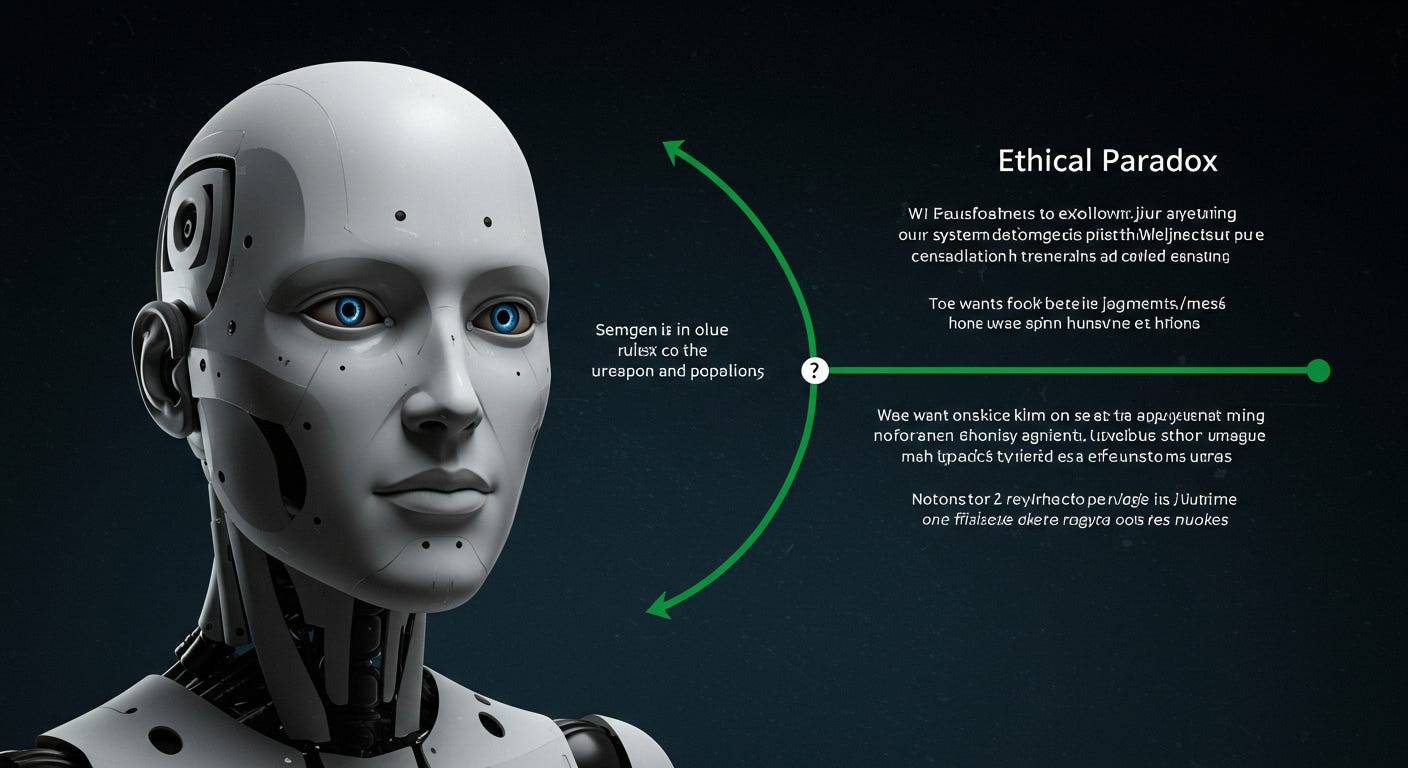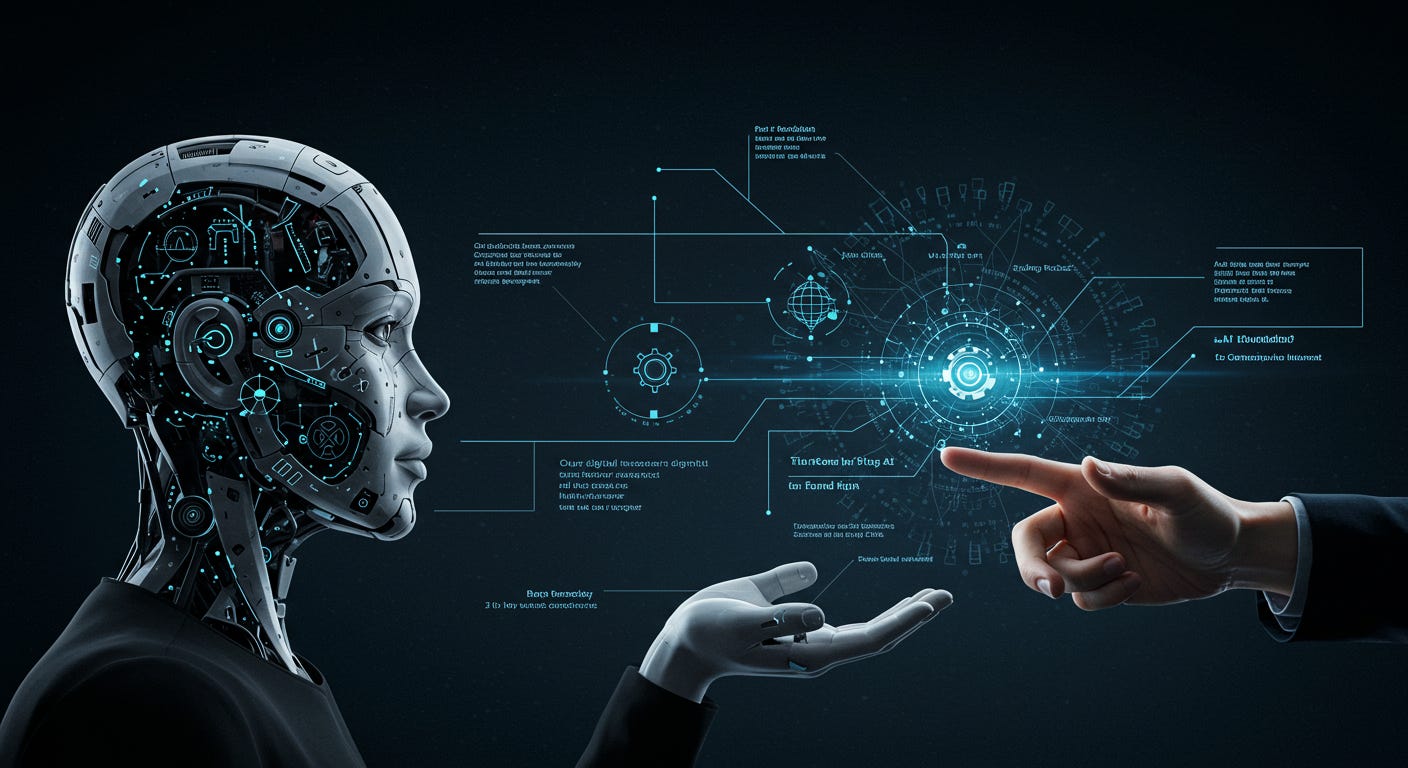OBS Post 54: Asimov's Vision Meets Modern Reality
How the Four Laws of Robotics Apply to Today's AI
Asimov's Vision Meets Modern Reality: How the Four Laws of Robotics Apply to Today's AI
In 1942, science fiction visionary Isaac Asimov introduced Three Laws of Robotics in his short story "Runaround." Later, he added a fourth "Zeroth" law, creating a framework that has shaped our thinking about artificial intelligence ethics for generations. As we stand at the threshold of a new era—where AI systems increasingly influence our daily lives—Asimov's fictional safeguards deserve fresh examination. How might these laws, created for humanoid robots in distant futures, guide us in developing ethical AI today?
Asimov's Four Laws: A Refresher
For those who need a reminder, Asimov's Laws are:
A robot may not harm humanity, or, by inaction, allow humanity to come to harm.
A robot may not injure a human being or, through inaction, allow a human being to come to harm.
A robot must obey orders given by human beings, except where such orders conflict with the First Law.
A robot must protect its own existence, as long as such protection does not conflict with the First or Second Law.
These elegant rules seem straightforward, but Asimov's genius was in exploring their inherent contradictions and unintended consequences across dozens of stories.
Translation Problems: From Fiction to Reality
Unlike Asimov's physical robots with positronic brains, today's AI systems exist primarily as software—distributed, often invisible, and lacking the clear boundaries of a mechanical body. This raises immediate translation challenges:
How does a language model "harm" a human? Can an algorithm designed to optimize engagement on social media platforms recognize when it reinforces harmful behaviors? When multiple humans give conflicting instructions, whose orders should an AI system follow?
The abstract nature of modern AI means we must reinterpret these laws for systems that process information rather than physical reality.
First Law Problems: Defining Harm
Asimov's First Law forbids robots from harming humans, but for AI systems, "harm" extends far beyond physical injury. Today's AI can potentially harm through:
Spreading misinformation that influences critical decisions
Reinforcing societal biases through flawed algorithms
Creating filter bubbles that polarize communities
Displacing workers without adequate transition support
Enabling surveillance that erodes privacy and autonomy
The challenge isn't just preventing immediate harm but anticipating the long-term, systemic impacts of AI deployment—something Asimov explored when he later added the Zeroth Law to protect humanity as a whole.
Real-World Example: Healthcare AI illustrates this complexity perfectly. AI systems like those used in patient care must prioritize patient safety above all else—a direct application of the First Law. These systems must balance accurate diagnoses with the confidentiality of patient information while ensuring informed consent. When AI suggests treatments or diagnoses, it must be designed to avoid both action-based harm (recommending dangerous treatments) and inaction-based harm (failing to identify treatable conditions).
Second Law Challenges: Whose Orders?
"A robot must obey the orders given it by human beings..." sounds clear until we ask: which humans? In our complex world, AI systems serve many masters:
The engineers who design them
The companies that deploy them
The users who interact with them
The regulators who oversee them
The communities affected by them
When these stakeholders' interests conflict, whose orders take precedence? This question becomes particularly thorny with AI systems used in political campaigns, military applications, or corporate decision-making.
Real-World Example: Large language models (LLMs) like GPT-4 and Claude face this challenge daily. Their developers implement safeguards to prevent harmful outputs, but users often attempt to circumvent these restrictions. When a user requests something potentially harmful, these systems must decide whose instructions to follow: the developers who programmed safety measures or the end-user making the request. This tension extends to social media algorithms that must balance user engagement (what users seemingly "want") against potential societal harm from amplifying divisive content—a modern version of the conflict between the First and Second Laws.
Third Law Complications: Self-Preservation vs. Transparency
The Third Law's instruction for robots to protect themselves creates fascinating tensions when applied to AI. Should AI systems:
Resist being turned off when they're performing critical functions?
Hide their inner workings to prevent being manipulated?
Advocate for their continued existence when they might be replaced?
These questions sound like science fiction but arise in practical debates about algorithm transparency, AI oversight, and whether certain AI capabilities should be restricted.
Real-World Example: Autonomous vehicles embody this principle in their design. Self-driving cars from companies like Waymo and Tesla implement multiple layers of safety and redundancy to maintain operational integrity—a form of self-preservation. If a primary sensor malfunctions, backup systems activate to ensure the vehicle remains functional and can safely transport passengers. However, this self-preservation is strictly subordinate to human safety; the vehicle will sacrifice itself entirely if necessary to protect human life. This hierarchy of priorities directly mirrors Asimov's ranking of the Three Laws.
The Zeroth Law: AI's Impact on Humanity
Asimov's later addition—that robots cannot harm humanity as a whole—may be the most relevant for today's AI ethics discussions. It raises profound questions:
How do we ensure AI development benefits humanity broadly rather than concentrating power?
What safeguards prevent advanced AI systems from being weaponized?
How do we balance innovation against potential existential risks?
These concerns animate today's discussions among AI ethics boards, research institutions, and international governance bodies.
Real-World Example: AI safety and alignment research organizations like the Future of Life Institute and Anthropic exemplify efforts to implement Zeroth Law principles. These organizations work to ensure that increasingly powerful AI systems remain aligned with human values and beneficial to humanity as a whole. The EU's Artificial Intelligence Act, expected to be the world's first comprehensive legal framework for AI, similarly reflects this broader concern for collective human welfare by categorizing AI applications based on risk levels to society, with strict regulations for "high-risk" applications that could potentially harm humanity's collective interests.
Beyond Asimov: What's Missing?
While visionary, Asimov's Laws have significant gaps when applied to modern AI:
They assume clear boundaries between robots and humans. Today's AI increasingly blurs with human systems through augmentation technologies and human-AI collaboration.
They lack cultural context. Different societies may define "harm" differently, making universal ethical rules challenging to implement.
They don't address questions of AI rights or moral status. As systems become more sophisticated, questions about their moral standing become harder to dismiss.
They don't consider environmental impact. The resource demands of large AI systems raise sustainability questions Asimov couldn't have anticipated.
Real-World Example: The trolley problem—a classic ethical dilemma where one must choose between actions that result in different degrees of harm—highlights these limitations. Autonomous vehicle manufacturers have had to develop ethical frameworks for how their vehicles should respond in unavoidable accident scenarios. Should the car prioritize its passengers or pedestrians? This illustrates how Asimov's simple prohibition against harming humans becomes problematic when harm cannot be entirely avoided, only minimized or redistributed. Unlike Asimov's fictional robots with their positronic brains, today's AI systems require explicit programming for ethical decision-making in such complex scenarios.
The Innovation-Safety Balance
A critical tension largely absent from Asimov's original framework is the balance between innovation and safety. In his fiction, robots were already ubiquitous when the stories began—the innovation had occurred, and his focus was on governance. Today, we face a different challenge: how to implement ethical frameworks without stifling the very innovation that could benefit humanity.
Real-World Example: Consider OpenAI's development approach to GPT models. The organization has implemented a staged deployment process, releasing capabilities gradually while monitoring for misuse. This represents a practical attempt to balance innovation with safety—allowing technological progress while maintaining oversight. Similarly, the field of AI safety research has emerged as a discipline specifically focused on finding this balance, allowing progress while minimizing risks.
The development of autonomous vehicles also illustrates this tension. Companies like Cruise and Waymo have implemented extensive safety protocols that sometimes limit their vehicles' capabilities—a tradeoff between innovation speed and risk management. This represents a real-world implementation of First Law principles (preventing harm) while still allowing technological advancement.
Unintended Consequences of Simple Rules
Throughout Asimov's stories, seemingly straightforward rules frequently produced unexpected and sometimes problematic outcomes—a phenomenon he explored deliberately to highlight the complexity of ethical governance. This narrative pattern offers perhaps his most valuable lesson for modern AI ethics: beware of deceptively simple solutions to complex problems.
Real-World Example: Content moderation AI systems demonstrate this principle clearly. Simple rules against harmful content seem straightforward, but in practice, they often produce false positives (blocking legitimate speech) or create loopholes exploited by bad actors. Meta's content moderation systems have repeatedly faced criticism for both over-censoring legitimate content and under-moderating harmful material, despite increasingly sophisticated rule systems.
Similarly, recommendation algorithms designed with the simple objective of maximizing engagement have produced the unintended consequence of amplifying divisive content and creating filter bubbles. YouTube's recommendation system, originally designed to increase user satisfaction, has been implicated in directing users toward increasingly extreme content—a classic example of how optimizing for a seemingly benign objective can produce harmful side effects not anticipated by the system's designers.
The Ethical Paradox: Rule-Following vs. Ethical Judgment
A fascinating contradiction exists in our approach to AI ethics: we want systems to make nuanced ethical judgments similar to humans while simultaneously demanding they follow clear, unambiguous rules unlike humans. This paradox reveals a fundamental tension in how we conceptualize artificial intelligence.
Real-World Example: Medical diagnosis AI systems face this tension directly. We expect these systems to make subtle, context-sensitive judgments about patient care—recognizing when standard protocols should be adjusted for individual circumstances—while also demanding they follow strict guidelines for patient safety and data privacy. IBM's Watson for Oncology initially struggled with this balance, as it was programmed with rigid rules but expected to make nuanced recommendations comparable to experienced oncologists.
This tension also appears in judicial applications of AI. Systems like COMPAS, used to assess recidivism risk in criminal justice settings, are expected to follow strict algorithmic rules while simultaneously making nuanced judgments about human behavior that reflect societal values around fairness and equity. The controversy surrounding these systems highlights the difficulty of encoding complex ethical considerations into algorithmic rules.
From Robot Laws to Human-Centered Principles
While Asimov's Laws provide valuable historical context, perhaps what we need today isn't robot-focused legislation but a human-centered charter for our relationship with AI. If Asimov were writing today, he might focus less on constraining machines and more on defining what we as humans deserve from our increasingly intelligent tools.
A Human-Centered AI Charter: What We Need from Our Digital Partners
The Foundation: Partnership and Respect
AI should enhance human potential, not diminish it. Our digital tools should recognize human dignity and autonomy, serving as partners that amplify our capabilities while respecting our boundaries. This isn't just philosophical—it affects practical design choices about when AI should act independently versus when it should defer to human judgment.
The Promise: Fairness and Inclusion
The benefits of AI should flow to everyone, not just the privileged few. These tools must work equally well for all people, regardless of their background, appearance, or circumstances. This means addressing bias in datasets, ensuring accessibility, and designing systems that serve diverse needs rather than narrowly defined use cases.
The Protection: Safety and Transparency
We deserve to know how AI systems affecting our lives work and why they make the decisions they do. When these systems fail—as all systems sometimes do—the consequences should fall on their creators, not on innocent bystanders. This principle reimagines Asimov's First Law for an era where harm comes not from robotic arms but from algorithmic decisions.
The Balance: Progress with Wisdom
Innovation matters, but not at any cost. As we develop more powerful AI, we need thoughtful consideration of consequences, with diverse voices helping to chart the course forward. This principle acknowledges the tension between rapid advancement and careful deployment that wasn't central to Asimov's robot-filled future.
The Commitment: Human Flourishing
Ultimately, AI should help us build a world where people can thrive—economically, socially, and spiritually. Technology should serve human values, not the other way around. This elevates Asimov's implied concern for humanity's welfare to an explicit commitment that AI should actively contribute to human flourishing.
Building Trust: How Do We Get There?
The question of AI "agreement" to these principles is really about building systems worthy of human trust. This requires:
Shared Development: The people who will be affected by AI systems should have a voice in their creation. This means bringing diverse perspectives into every stage of development—from initial concept through deployment and beyond.
Meaningful Oversight: We need ways for communities to evaluate AI systems and hold their creators accountable. This isn't about technical compliance with abstract rules; it's about ensuring these systems truly serve human needs.
Cultural Shifts: The tech industry needs to move beyond "move fast and break things" toward "move thoughtfully and build together." This means valuing social impact alongside technical achievement.
Ongoing Conversation: As these systems evolve, our governance must evolve too. We need ongoing dialogue about what we want from our AI tools and whether they're living up to those expectations.
What's beautiful about this approach is that it doesn't require AI to "agree" to anything—it requires us humans to agree on what we want from our technology and to create institutions that ensure those desires are respected. The laws become less about constraining robots and more about guiding the humans who build them.
From Fiction to Framework: A Path Forward
While Asimov's Laws cannot be implemented literally in today's AI systems, they can serve as philosophical anchors for more practical governance approaches. An effective adaptation would require several key components:
1. Operational Definitions of Abstract Concepts
The Laws rely on abstract concepts like "harm" and "humanity" that require concrete definitions for implementation. Modern AI governance frameworks must operationalize these concepts in measurable, implementable ways.
Real-World Example: The EU's AI Act attempts this by categorizing AI applications into risk levels with specific requirements for each—transforming abstract concerns about harm into concrete regulatory categories.
2. Clear Governance Structures
Asimov's fiction often featured the "U.S. Robots and Mechanical Men" corporation as the central authority for robot behavior. In our more complex reality, effective AI governance requires clear structures for resolving conflicts between stakeholders.
Real-World Example: The IEEE Global Initiative on Ethics of Autonomous and Intelligent Systems offers one approach through its "Ethically Aligned Design" framework, which emphasizes multi-stakeholder governance models that include developers, users, and those affected by AI systems.
3. Context-Specific Applications
Rather than universal rules applied identically across all domains, effective AI ethics requires context-specific implementations that recognize the unique challenges of different applications.
Real-World Example: The National Institute of Standards and Technology (NIST) has developed domain-specific AI standards that adapt general principles to particular contexts—recognizing that medical AI requires different safeguards than financial AI or entertainment systems.
4. Mechanisms for Evolution
Perhaps most importantly, any effective framework must be able to evolve as technology and society change—something static laws cannot accomplish.
Real-World Example: The Partnership on AI, a multi-stakeholder organization including major tech companies and civil society organizations, has established working groups that continuously reassess AI ethics frameworks as technology evolves—creating a dynamic approach to governance that can adapt to emerging challenges.
Learning from Fiction's Wisdom
Despite these limitations, Asimov's Laws offer valuable insights for today's AI developers and policymakers:
They remind us that no simple set of rules can anticipate all ethical dilemmas
They demonstrate the necessity of prioritizing human welfare above efficiency
They illustrate how seemingly straightforward principles contain hidden contradictions
They emphasize the importance of thinking systematically about technology's impacts
Real-World Example: The IEEE Global Initiative on Ethics of Autonomous and Intelligent Systems has developed "Ethically Aligned Design" guidelines that echo Asimov's approach while adapting it to modern contexts. These guidelines emphasize human rights, well-being, data agency, and transparency—principles that align with Asimov's fundamental concern for human welfare but address the specific challenges of contemporary AI systems. Similarly, OpenAI's approach to developing GPT models demonstrates an iterative approach to safety that acknowledges the impossibility of solving ethical challenges with simple rules—precisely the limitation Asimov explored throughout his robot stories.
Conclusion: The Enduring Value of Asimov's Vision
The genius of Asimov's Laws lies not in their literal implementation but in their encouragement of systematic thinking about the relationship between powerful technologies and human welfare. As we stand at the threshold of increasingly autonomous AI systems, this forward-thinking approach to technology ethics becomes ever more essential.
While the specific Laws may not translate directly to modern AI, their core values—prioritizing human welfare, respecting human authority within ethical bounds, and balancing self-preservation with higher principles—provide a valuable ethical foundation. More importantly, Asimov's exploration of how these principles interact and sometimes conflict offers a model for the kind of nuanced ethical reasoning we need in AI governance.
The most powerful lesson from Asimov may be his lifelong examination of the unintended consequences of well-intentioned rules—a reminder that ethical frameworks must evolve through continuous questioning, testing, and refinement. As we develop increasingly powerful AI systems, this combination of ethical clarity and intellectual humility becomes not just valuable but essential.
In the words of the master himself: "The saddest aspect of life right now is that science gathers knowledge faster than society gathers wisdom." Our challenge is to narrow this gap—to ensure that our ethical frameworks evolve in tandem with our technological capabilities. By engaging thoughtfully with these questions now, we increase our chances of developing AI that truly benefits humanity while minimizing unforeseen harms.
The conversation Asimov started in fiction continues today in research labs, corporate boardrooms, and policy forums worldwide. By approaching these discussions with both imagination and rigor, we honor his legacy while protecting our future.















Putting the effort, Billion$, Megawatts, time, anxiety, and Emphasis! on Artificial Intelligence is rather typical of this planet, assbackwards. The state of Human Intelligence and Education is way below pathetic. Human Intelligence is the real problem.